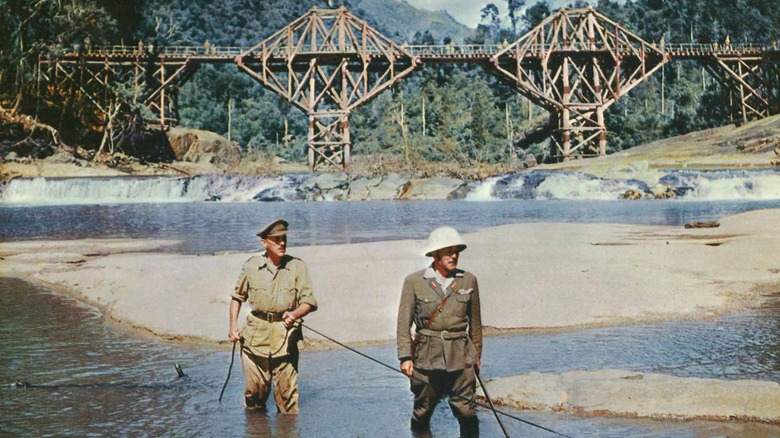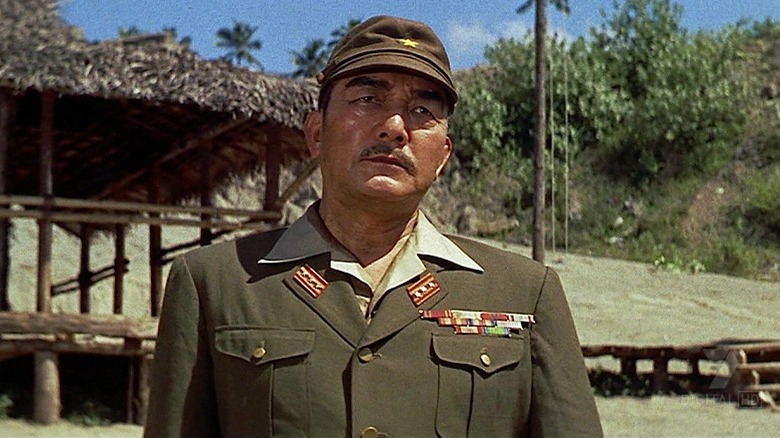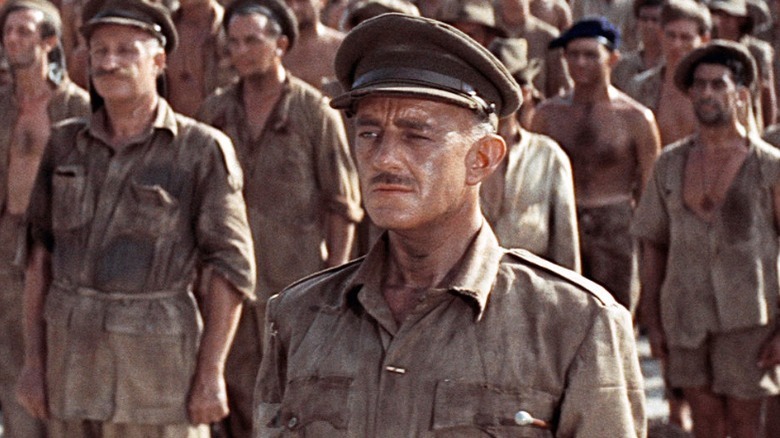The Tragic Real-Life Story That Inspired Bridge On The River Kwai
"The Bridge on the River Kwai" is one of the great prisoners of war films, balancing contemplative moments with heart-pumping action and intrigue. The film compares and contrasts the honor systems of clashing, warring cultures, focusing on individual interactions between POWs and their captors during the notorious Siam-Burma railway project. Unfortunately, the real-life forced labor that constructed the Burma railway was a hopeless and brutal death sentence that didn't allow much time for self-reflection.
Directed by David Lean and scripted by blacklisted writers Carl Foreman and Michael Wilson, "The Bridge on the River Kwai" is based on a novel written by French author, spy, and former POW Pierre Boulle. Both the film and the novel are fictional accounts of the forced labor camps along the Burma-Siam railway, chillingly nicknamed the "Death Railway." Interestingly, protagonist Colonel Nicholson, played by Alec Guinness, and those who serve under him are British rather than French, even though Boulle based his character on fellow French POWs he met while under forced labor in Vichy French Indochina. The novel and the film explore the honor code of Nicholson, who is determined and headstrong in his pursuit to help build the railway bridge, even if the task is under orders of the occupying forces.
The Death Railway
Although "The Bridge on the River Kwai" plainly shows the atrocities that occurred in Japanese POW camps, the real Death Railway project was even more inhumane. Looking to gain a stronger foothold in Southeast Asia and supply its troops in the Burma Campaign without navigating the treacherous, submarine-filled waters of the Pacific, Japan ordered the construction of the railway to connect Thailand (then called Siam) with southern Burma (now called Myanmar). The planned route ran through thick jungles, crossed flowing rivers, and cut through rugged mountains, but Japan's immense supply of POWs meant that the effort was worth the cost. The result was brutal, as thousands of POWs and native civilians lost their lives due to mistreatment and harsh conditions.
Laborers were forced to work with rudimentary tools despite the scale of the project, hacking at bamboo and hammering at rock, all while working 18-hour shifts to ensure a speedy completion. Construction occurred during monsoon season, meaning that the laborers were constantly battling torrential rain and malaria-infected mosquitos. The only dining options the prisoners had were rice and rancid, maggot-covered meat and fish, adding dysentery and diarrhea to the list of killer diseases that plagued the labor force. The commandants who oversaw the project punished the prisoners if they thought construction wasn't moving fast enough, prodding them with bayonets. If any of them had the nerve to show any disobedience, they saw the inside of a solitary confinement box, a punishment that is inflicted on Colonel Nicholson in "The Bridge on the River Kwai."
An Atrocity Downplayed?
The harsher reality of the Burma Railway as compared to "The Bridge on the River Kwai" may make viewers think that the film does a disservice to the real-life plights of those who were forced to give up their lives in forced labor. It may be difficult to accept that people like Colonel Nicholson would be so personally dogged in real life, considering how malnourished and disease-ridden the prisoners were.
There's an argument to be made that "The Bridge on the River Kwai" romanticizes the experiences of POWs. On the other hand, Colonel Nicholson's morality is certainly called into question, as he eventually takes over the forced project himself out of a misguided sense of pride. Films such as these show how inhumane conditions can corrupt humanity, and how war can distort a sense of honor. Sadly, the laborers who worked on the real Burma Railway died before they could turn into Nicholsons. Conditions were so terrible that it's doubtful that the POWs were motivated by anything other than violent punishment. Still, "The Bridge on the River Kwai" may help to put a face on the thousands of people who died in the jungle. Ultimately, the film commemorates the real individuals involved in the tragedy of the Burma Railway.


